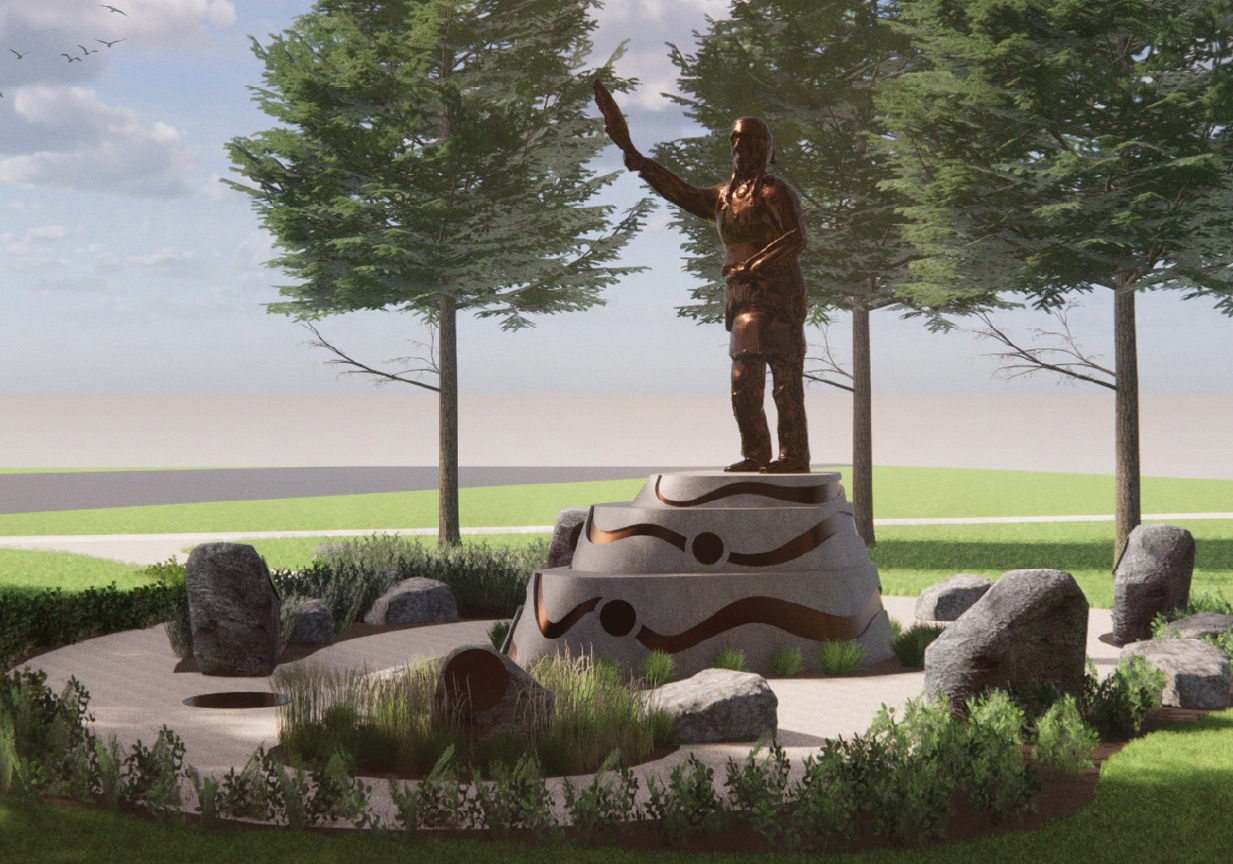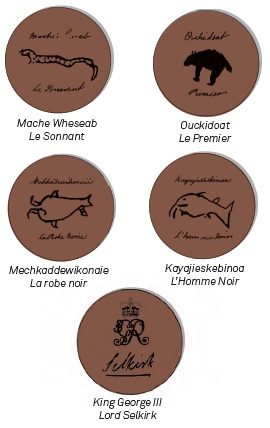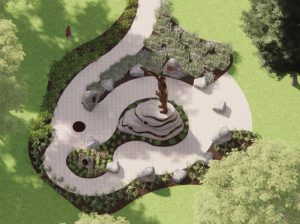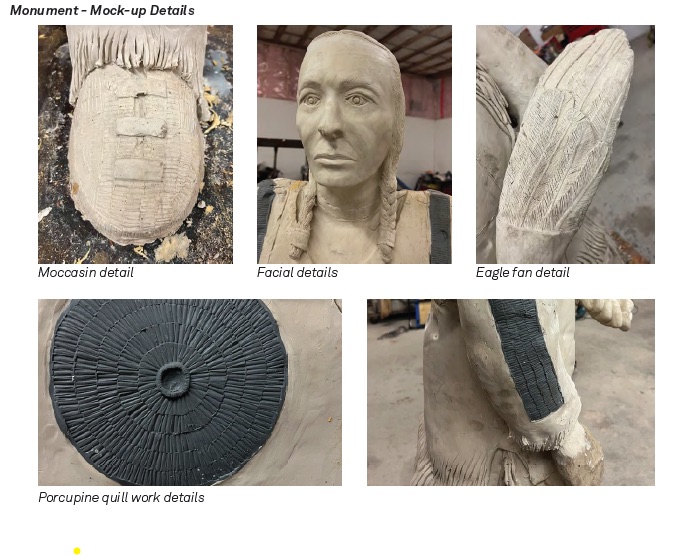
The final design of the Peguis Selkirk Treaty Monument was announced on August 24, 2023, on the future site of the monument at the Manitoba Legislative Building. It will become the first monument recognizing First Nations’ contributions to the founding and development of Manitoba on the Legislative Building grounds.
In addition to commemorating the Treaty and those who signed it, the monument is intended to represent and honour all First Nations people, contributing to reconciliation. It is also intended to remind us all of the spirit of sharing and cooperation between First Nations and the Crown, inherent in this and all Treaties.
 The monument design was submitted by sculptor Wayne Stranger and his son Jordan Stranger, of Peguis First Nation, together with the Winnipeg landscape design firm BrookMcIlroy. It will feature a bronze statue of Chief Peguis as well as bronze medallions representing the four other Cree and Saulteaux chiefs who signed the Treaty – Mache Wheseab, Le Sonnant; Mechkaddewikonaie, La robe noir; Kayajieskebinoa, L’Homme Noir; and Ouckidoat, Le Premier. A fifth bronze medallion will represent the other signatory to the Treaty, Thomas Douglas, 5th Earl of Selkirk on behalf of His Majesty King George III.
The monument design was submitted by sculptor Wayne Stranger and his son Jordan Stranger, of Peguis First Nation, together with the Winnipeg landscape design firm BrookMcIlroy. It will feature a bronze statue of Chief Peguis as well as bronze medallions representing the four other Cree and Saulteaux chiefs who signed the Treaty – Mache Wheseab, Le Sonnant; Mechkaddewikonaie, La robe noir; Kayajieskebinoa, L’Homme Noir; and Ouckidoat, Le Premier. A fifth bronze medallion will represent the other signatory to the Treaty, Thomas Douglas, 5th Earl of Selkirk on behalf of His Majesty King George III.

Bird’s eye view
The stones and bronze plaques are arranged to convey the history of the four independent chiefs and nations coming together with Chief Peguis and his nation to enter into the Treaty with Lord Selkirk and the Crown. The inner planted area surrounding the statue flows through to the area surrounding the stone and plaque representing the Crown, thus representing the sacred Treaty relationship.
The design integrates layers of storytelling with the physical connection to the land and to the history of Chief Peguis, which is communicated through materials, colour, pictographs and language. The cardinal directions and the monument’s orientation to the east is emphasized with the surrounding limestone pathway. The layout of the accessible path frames the statue and moves the visitor from the east entry, clockwise (sun-wise) around the monument.
As the visitor moves through the east, they are presented with a bronze medallion on the ground plane signifying the importance of fire as an element of survival, as well as unity. This medallion provides a threshold in which to enter the space with large stones positioned in a circular formation, framing the monument site. The stones are reflective of the moons and the full calendar year with the medallion being the thirteenth moon, a symbol of the Anishinaabe calendar. In this format the visitor can understand the importance of the cycles of life.
Surrounding the pathway and statue are plantings that link to the prairie landscape, as well as the medicinal uses by the many Indigenous nations of the area. These include, prairie sage in the south, cedar in the north, prairies grasses / shrubs in the west, and perennial flowers and medicinal mixtures, such as bearberry in the east. The directional plantings of the project create an opportunity for learning and ceremony and also symbolize the land of Manitoba, where Peguis became who he was.
 The stones surrounding the statue will include seating stones for sitting, viewing and gathering. Situated among the seating stones will be four (4) larger stones with bronze medallions featuring the names and totems of the chiefs: Mache Wheseab, Le Sonnant; Mechkaddewikonaie, La robe noir; Kayajieskebinoa, L’Homme Noir; and Ouckidoat, Le Premier. In addition, a fifth stone will display a medallion representing King George III and Lord Selkirk.
The stones surrounding the statue will include seating stones for sitting, viewing and gathering. Situated among the seating stones will be four (4) larger stones with bronze medallions featuring the names and totems of the chiefs: Mache Wheseab, Le Sonnant; Mechkaddewikonaie, La robe noir; Kayajieskebinoa, L’Homme Noir; and Ouckidoat, Le Premier. In addition, a fifth stone will display a medallion representing King George III and Lord Selkirk.
The limestone material of the pathway is a linkage to the pedestal of the statue, creating a blurred transition between the ground and the base of the monument. The statue will be supported on a Tyndall stone base which is common throughout the legislative grounds however the proposed design for this project will depart from the more typical rectilinear massing and focus on a faceted or curvilinear expression. This more organic approach is meant to soften the overall appearance and break down the form, further emphasizing the connection between the natural world and ourselves.
The stone base also provides narrative and content, integrating treaty information, clan symbology and storytelling that elaborate on the meaning of the monument, significance of the Treaty and emphasize the contributions of all First Nations people in the founding and development of Manitoba. We envision a surface that is sinuous linework furthering the “everything is connected” narrative; beings, lands and waters. This linework is conceived of as a ribbon of bronze with inset imagery and text including various bronze medallions highlighting key points in history and featuring the totems of Peguis and the other chiefs.

